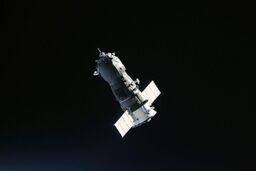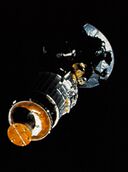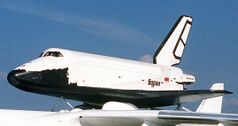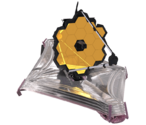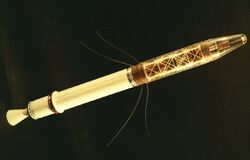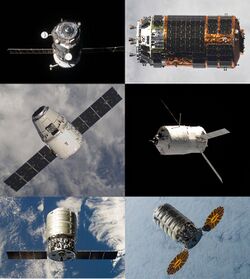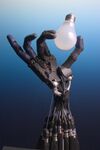Uncrewed spacecraft
Topic: Engineering
 From HandWiki - Reading time: 19 min
From HandWiki - Reading time: 19 min
Bottom: Spaceplane Buran was launched, orbited Earth, and landed as an uncrewed spacecraft in 1988 (left). Model of James Webb Space Telescope (right).
Robotic spacecraft or uncrewed spacecraft are spacecraft without people on board. Uncrewed spacecraft may have varying levels of autonomy from human input; they may be remote controlled, remote guided or even autonomous, meaning they have a pre-programmed list of operations, which they will execute unless otherwise instructed. A robotic spacecraft designed to make scientific research measurements is often called a space probe or space observatory.
Many space missions are more suited to telerobotic rather than crewed operation, due to lower cost and lower risk factors. In addition, some planetary destinations such as Venus or the vicinity of Jupiter are too hostile for human survival, given current technology. Outer planets such as Saturn, Uranus, and Neptune are too distant to reach with current crewed spaceflight technology, so telerobotic probes are the only way to explore them. Telerobotics also allows exploration of regions that are vulnerable to contamination by Earth micro-organisms since spacecraft can be sterilized. Humans can not be sterilized in the same way as a spaceship, as they coexist with numerous micro-organisms, and these micro-organisms are also hard to contain within a spaceship or spacesuit.
The first uncrewed space mission was Sputnik, launched October 4, 1957 to orbit the Earth. Nearly all satellites, landers and rovers are robotic spacecraft. Not every uncrewed spacecraft is a robotic spacecraft; for example, a reflector ball is a non-robotic uncrewed spacecraft. Space missions where other animals but no humans are on-board are called uncrewed missions.
Many habitable spacecraft also have varying levels of robotic features. For example, the space stations Salyut 7 and Mir, and the International Space Station module Zarya, were capable of remote guided station-keeping and docking maneuvers with both resupply craft and new modules. Uncrewed resupply spacecraft are increasingly used for crewed space stations.
History
The first robotic spacecraft was launched by the Soviet Union (USSR) on 22 July 1951, a suborbital flight carrying two dogs Dezik and Tsygan.[1] Four other such flights were made through the fall of 1951.
The first artificial satellite, Sputnik 1, was put into a 215-by-939-kilometer (116 by 507 nmi) Earth orbit by the USSR on 4 October 1957. On 3 November 1957, the USSR orbited Sputnik 2. Weighing 113 kilograms (249 lb), Sputnik 2 carried the first animal into orbit, the dog Laika.[2] Since the satellite was not designed to detach from its launch vehicle's upper stage, the total mass in orbit was 508.3 kilograms (1,121 lb).[3]
In a close race with the Soviets, the United States launched its first artificial satellite, Explorer 1, into a 357-by-2,543-kilometre (193 by 1,373 nmi) orbit on 31 January 1958. Explorer I was an 205-centimetre (80.75 in) long by 15.2-centimetre (6.00 in) diameter cylinder weighing 14.0 kilograms (30.8 lb), compared to Sputnik 1, a 58-centimeter (23 in) sphere which weighed 83.6 kilograms (184 lb). Explorer 1 carried sensors which confirmed the existence of the Van Allen belts, a major scientific discovery at the time, while Sputnik 1 carried no scientific sensors. On 17 March 1958, the US orbited its second satellite, Vanguard 1, which was about the size of a grapefruit, and remains in a 670-by-3,850-kilometre (360 by 2,080 nmi) orbit (As of 2016).
The first attempted lunar probe was the Luna E-1 No.1, launched on 23 September 1958. The goal of a lunar probe repeatedly failed until 4 January 1959 when Luna 1 orbited around the Moon and then the Sun.
The success of these early missions began a race between the US and the USSR to outdo each other with increasingly ambitious probes. Mariner 2 was the first probe to study another planet, revealing Venus' extremely hot temperature to scientists in 1962, while the Soviet Venera 4 was the first atmospheric probe to study Venus. Mariner 4 's 1965 Mars flyby snapped the first images of its cratered surface, which the Soviets responded to a few months later with images from on its surface from Luna 9. In 1967, America's Surveyor 3 gathered information about the Moon's surface that would prove crucial to the Apollo 11 mission that landed humans on the Moon two years later.[4]
The first interstellar probe was Voyager 1, launched 5 September 1977. It entered interstellar space on 25 August 2012,[5] followed by its twin Voyager 2 on 5 November 2018.[6]
Nine other countries have successfully launched satellites using their own launch vehicles: France (1965), Japan and China (1970), the United Kingdom (1971), India (1980), Israel (1988), Iran (2009), and North Korea (2012).Cite error: Closing </ref> missing for <ref> tag
Design
In spacecraft design, the United States Air Force considers a vehicle to consist of the mission payload and the bus (or platform). The bus provides physical structure, thermal control, electrical power, attitude control and telemetry, tracking and commanding.[7]
JPL divides the "flight system" of a spacecraft into subsystems.[8] These include:
Structure
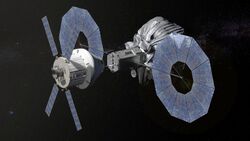
This is the physical backbone structure. It:
- provides overall mechanical integrity of the spacecraft
- ensures spacecraft components are supported and can withstand launch loads
Data handling
This is sometimes referred to as the command and data subsystem. It is often responsible for:
- command sequence storage
- maintaining the spacecraft clock
- collecting and reporting spacecraft telemetry data (e.g. spacecraft health)
- collecting and reporting mission data (e.g. photographic images)
Attitude determination and control
This system is mainly responsible for the correct spacecraft's orientation in space (attitude) despite external disturbance-gravity gradient effects, magnetic-field torques, solar radiation and aerodynamic drag; in addition it may be required to reposition movable parts, such as antennas and solar arrays.[9]
Landing on hazardous terrain
In planetary exploration missions involving robotic spacecraft, there are three key parts in the processes of landing on the surface of the planet to ensure a safe and successful landing.[10] This process includes an entry into the planetary gravity field and atmosphere, a descent through that atmosphere towards an intended/targeted region of scientific value, and a safe landing that guarantees the integrity of the instrumentation on the craft is preserved. While the robotic spacecraft is going through those parts, it must also be capable of estimating its position compared to the surface in order to ensure reliable control of itself and its ability to maneuver well. The robotic spacecraft must also efficiently perform hazard assessment and trajectory adjustments in real time to avoid hazards. To achieve this, the robotic spacecraft requires accurate knowledge of where the spacecraft is located relative to the surface (localization), what may pose as hazards from the terrain (hazard assessment), and where the spacecraft should presently be headed (hazard avoidance). Without the capability for operations for localization, hazard assessment, and avoidance, the robotic spacecraft becomes unsafe and can easily enter dangerous situations such as surface collisions, undesirable fuel consumption levels, and/or unsafe maneuvers.
Entry, descent, and landing
Integrated sensing incorporates an image transformation algorithm to interpret the immediate imagery land data, perform a real-time detection and avoidance of terrain hazards that may impede safe landing, and increase the accuracy of landing at a desired site of interest using landmark localization techniques. Integrated sensing completes these tasks by relying on pre-recorded information and cameras to understand its location and determine its position and whether it is correct or needs to make any corrections (localization). The cameras are also used to detect any possible hazards whether it is increased fuel consumption or it is a physical hazard such as a poor landing spot in a crater or cliff side that would make landing very not ideal (hazard assessment).
Telecommunications
Components in the telecommunications subsystem include radio antennas, transmitters and receivers. These may be used to communicate with ground stations on Earth, or with other spacecraft.[11]
Electrical power
The supply of electric power on spacecraft generally come from photovoltaic (solar) cells or from a radioisotope thermoelectric generator. Other components of the subsystem include batteries for storing power and distribution circuitry that connects components to the power sources.[12]
Temperature control and protection from the environment
Spacecraft are often protected from temperature fluctuations with insulation. Some spacecraft use mirrors and sunshades for additional protection from solar heating. They also often need shielding from micrometeoroids and orbital debris.[13]
Propulsion
Spacecraft propulsion is a method that allows a spacecraft to travel through space by generating thrust to push it forward.[14] However, there is not one universally used propulsion system: monopropellant, bipropellant, ion propulsion, etc. Each propulsion system generates thrust in slightly different ways with each system having its own advantages and disadvantages. But, most spacecraft propulsion today is based on rocket engines. The general idea behind rocket engines is that when an oxidizer meets the fuel source, there is explosive release of energy and heat at high speeds, which propels the spacecraft forward. This happens due to one basic principle known as Newton's Third Law. According to Newton, "to every action there is an equal and opposite reaction." As the energy and heat is being released from the back of the spacecraft, gas particles are being pushed around to allow the spacecraft to propel forward. The main reason behind the usage of rocket engine today is because rockets are the most powerful form of propulsion there is.
Monopropellant
For a propulsion system to work, there is usually an oxidizer line and a fuel line. This way, the spacecraft propulsion is controlled. But in a monopropellant propulsion, there is no need for an oxidizer line and only requires the fuel line.[15] This works due to the oxidizer being chemically bonded into the fuel molecule itself. But for the propulsion system to be controlled, the combustion of the fuel can only occur due to a presence of a catalyst. This is quite advantageous due to making the rocket engine lighter and cheaper, easy to control, and more reliable. But, the downfall is that the chemical is very dangerous to manufacture, store, and transport.
Bipropellant
A bipropellant propulsion system is a rocket engine that uses a liquid propellent.[16] This means both the oxidizer and fuel line are in liquid states. This system is unique because it requires no ignition system, the two liquids would spontaneously combust as soon as they come into contact with each other and produces the propulsion to push the spacecraft forward. The main benefit for having this technology is because that these kinds of liquids have relatively high density, which allows the volume of the propellent tank to be small, therefore increasing space efficacy. The downside is the same as that of monopropellant propulsion system: very dangerous to manufacture, store, and transport.
Ion
An ion propulsion system is a type of engine that generates thrust by the means of electron bombardment or the acceleration of ions.[17] By shooting high-energy electrons to a propellant atom (neutrally charge), it removes electrons from the propellant atom and this results the propellant atom becoming a positively charged atom. The positively charged ions are guided to pass through positively charged grids that contains thousands of precise aligned holes are running at high voltages. Then, the aligned positively charged ions accelerates through a negative charged accelerator grid that further increases the speed of the ions up to 40 kilometres per second (90,000 mph). The momentum of these positively charged ions provides the thrust to propel the spacecraft forward. The advantage of having this kind of propulsion is that it is incredibly efficient in maintaining constant velocity, which is needed for deep-space travel. However, the amount of thrust produced is extremely low and that it needs a lot of electrical power to operate.
Mechanical devices
Mechanical components often need to be moved for deployment after launch or prior to landing. In addition to the use of motors, many one-time movements are controlled by pyrotechnic devices.[18]
Robotic vs. uncrewed spacecraft
Robotic spacecraft are specifically designed system for a specific hostile environment.[19] Due to their specification for a particular environment, it varies greatly in complexity and capabilities. While an uncrewed spacecraft is a spacecraft without personnel or crew and is operated by automatic (proceeds with an action without human intervention) or remote control (with human intervention). The term 'uncrewed spacecraft' does not imply that the spacecraft is robotic.
Control
Robotic spacecraft use telemetry to radio back to Earth acquired data and vehicle status information. Although generally referred to as "remotely controlled" or "telerobotic", the earliest orbital spacecraft – such as Sputnik 1 and Explorer 1 – did not receive control signals from Earth. Soon after these first spacecraft, command systems were developed to allow remote control from the ground. Increased autonomy is important for distant probes where the light travel time prevents rapid decision and control from Earth. Newer probes such as Cassini–Huygens and the Mars Exploration Rovers are highly autonomous and use on-board computers to operate independently for extended periods of time.[20][21]
Space probes and observatories
A space probe is a robotic spacecraft that does not orbit Earth, but instead, explores further into outer space. Space probes have different sets of scientific instruments onboard. A space probe may approach the Moon; travel through interplanetary space; flyby, orbit, or land on other planetary bodies; or enter interstellar space. Space probes send collected data to Earth. Space probes can be orbiters, landers, and rovers. Space probes can also gather materials from its target and return it to Earth.[22][23]
Once a probe has left the vicinity of Earth, its trajectory will likely take it along an orbit around the Sun similar to the Earth's orbit. To reach another planet, the simplest practical method is a Hohmann transfer orbit. More complex techniques, such as gravitational slingshots, can be more fuel-efficient, though they may require the probe to spend more time in transit. Some high Delta-V missions (such as those with high inclination changes) can only be performed, within the limits of modern propulsion, using gravitational slingshots. A technique using very little propulsion, but requiring a considerable amount of time, is to follow a trajectory on the Interplanetary Transport Network.[citation needed]
A space telescope or space observatory is a telescope in outer space used to observe astronomical objects. Space telescopes avoid the filtering and distortion of electromagnetic radiation which they observe, and avoid light pollution which ground-based observatories encounter. They are divided into two types: satellites which map the entire sky (astronomical survey), and satellites which focus on selected astronomical objects or parts of the sky and beyond. Space telescopes are distinct from Earth imaging satellites, which point toward Earth for satellite imaging, applied for weather analysis, espionage, and other types of information gathering.
Cargo spacecraft
Cargo or resupply spacecraft are robotic spacecraft that are designed to carry cargo, possibly to support space stations' operation by transporting food, propellant and other supplies. This is different from a space probes, whose missions are to conduct scientific investigations.
Automated cargo spacecraft have been used since 1978 and have serviced Salyut 6, Salyut 7, Mir, the International Space Station and Tiangong space station.
As of 2023, three different cargo spacecraft are used to supply the International Space Station: Russian Progress, American SpaceX Dragon 2 and Cygnus. Chinese Tianzhou is used to supply Tiangong space station.
Robotic spacecraft service vehicles
- Mission Extension Vehicle is an alternative approach that does not utilize in-space RCS fuel transfer. Rather, it would connect to the target satellite in the same way as MDA SIS, and then use "its own thrusters to supply attitude control for the target."[24]
- OSAM-1[25] is NASA's Servicing, Assembly and Manufacturing engineering test mission. The vehicle has two robotic payloads with a total of three robot arms and performs multiple tasks: refueling an older Earth Observation satellite Landsat 7, constructing a communications antenna from segments, and manufacturing a structural beam.
See also
- Geosynchronous satellite
- Human spaceflight
- List of passive satellites
- Timeline of Solar System exploration
References
- ↑ Asif Siddiqi, Sputnik and the Soviet Space Challenge, University Press of Florida, 2003, ISBN:081302627X, p. 96
- ↑ Whitehouse, David (2002-10-28). "First dog in space died within hours". BBC News World Edition. http://news.bbc.co.uk/. "The animal, launched on a one-way trip on board Sputnik 2 in November 1957, was said to have died painlessly in orbit about a week after blast-off. Now, it has been revealed she died from overheating and panic just a few hours after the mission started."
- ↑ "Sputnik 2, Russian Space Web". 3 November 2012. http://www.russianspaceweb.com/sputnik2_decision.html.
- ↑ "NASA - What Is a Space Probe?". https://www.nasa.gov/centers/jpl/education/spaceprobe-20100225.html.
- ↑ Barnes, Brooks (12 September 2013). "In a Breathtaking First, NASA's Voyager 1 Exits the Solar System" (in en-US). The New York Times. ISSN 0362-4331. https://www.nytimes.com/2013/09/13/science/in-a-breathtaking-first-nasa-craft-exits-the-solar-system.html.
- ↑ Potter, Sean (9 December 2018). "NASA's Voyager 2 Probe Enters Interstellar Space". http://www.nasa.gov/press-release/nasa-s-voyager-2-probe-enters-interstellar-space.
- ↑ "Air University Space Primer, Chapter 10 – Spacecraft Design, Structure And Operation". USAF. http://space.au.af.mil/primer/spacecraft_design_structure_ops.pdf.
- ↑ "Chapter 11. Typical Onboard Systems". JPL. http://www2.jpl.nasa.gov/basics/bsf11-1.html.
- ↑ Wiley J. Larson; James R. Wertz(1999). Space Mission Analysis and Design, 3rd edition. Microcosm. pp. 354. ISBN:978-1-881883-10-4,
- ↑ Howard, Ayanna (January 2011). "Rethinking public–private space travel". Space Policy 29 (4): 266–271. doi:10.1016/j.spacepol.2013.08.002. Bibcode: 2013SpPol..29..266A.
- ↑ LU. K. KHODAREV (1979). "Space Communications". The Great Soviet Encyclopedia. http://encyclopedia2.thefreedictionary.com/. "The transmission of information between the earth and spacecraft, between two or more points on the earth via spacecraft or using artificial means located in space (a belt of needles, a cloud of ionized particles, and so on), and between two or more spacecraft."
- ↑ Wiley J. Larson; James R. Wertz(1999). Space Mission Analysis and Design, 3rd edition. Microcosm. pp. 409. ISBN:978-1-881883-10-4,
- ↑ "Micrometeoroid and Orbital Debris (MMOD) Protection". NASA. http://www.nasa.gov/externalflash/ISSRG/pdfs/mmod.pdf.
- ↑ Hall, Nancy (May 5, 2015). "Welcome to the Beginner's Guide to Propulsion". https://www.grc.nasa.gov/www/k-12/airplane/bgp.html.
- ↑ Zhang, Bin (October 2014). "A verification framework with application to a propulsion system". Expert Systems with Applications 41 (13): 5669–5679. doi:10.1016/j.eswa.2014.03.017.
- ↑ Chen, Yang (April 2017). "Dynamic modeling and simulation of an integral bipropellant propulsion double-valve combined test system". Acta Astronautica 133: 346–374. doi:10.1016/j.actaastro.2016.10.010. Bibcode: 2017AcAau.133..346C. https://qmro.qmul.ac.uk/xmlui/bitstream/123456789/18463/1/Wang%20Dynamic%20modeling%20and%20simulation%202016%20Accepted.pdf.
- ↑ Patterson, Michael (August 2017). "Ion Propulsion". https://www.nasa.gov/centers/glenn/about/fs21grc.html.
- ↑ Wiley J. Larson; James R. Wertz(1999). Space Mission Analysis and Design, 3rd edition. Microcosm. pp. 460. ISBN:978-1-881883-10-4,
- ↑ Davis, Phillips. "Basics of Space Flight". https://solarsystem.nasa.gov/basics/chapter9-1/.
- ↑ K. Schilling; W. Flury (1989-04-11). "AUTONOMY AND ON-BOARD MISSION MANAGEMENT ASPECTS FOR THE CASSINI-TITAN PROBE" (PDF). ATHENA MARS EXPLORATION ROVERS. http://www7.informatik.uni-wuerzburg.de/. "Current space missions exhibit a rapid growth in the requirements for on-board autonomy. This is the result of increases in mission complexity, intensity of mission activity and mission duration. In addition, for interplanetary spacecraft, the operations are characterized by complicated ground control access, due to the large distances and the relevant solar system environment[…] To handle these problemsn, the spacecraft design has to include some form of autonomous control capability."
- ↑ "Frequently Asked Questions (Athena for kids): Q) Is the rover controlled by itself or controlled by scientists on Earth?". ATHENA MARS EXPLORATION ROVERS. 2005. http://www.nasa.gov/externalflash/ISSRG/pdfs/mmod.pdf. "Communication with Earth is only twice per sol (martian day) so the rover is on its own (autonomous) for much of its journey across the martian landscape. Scientists send commands to the rover in a morning "uplink" and gather data in an afternoon "downlink." During an uplink, the rover is told where to go, but not exactly how to get there. Instead, the command contains the coordinates of waypoints toward a desired destination. The rover must navigate from waypoint to waypoint without human help. The rover has to use its "brain" and its "eyes" for these instances. The "brain" of each rover is the onboard computer software that tells the rover how to navigate based on what the Hazcams (hazard avoidance cameras) see. It is programmed with a given set of responses to a given set of circumstances. This is called "autonomy and hazard avoidance.""
- ↑ "NASA - What Is a Space Probe?" (in en). https://www.nasa.gov/centers/jpl/education/spaceprobe-20100225.html.
- ↑ "Space Probes" (in en). https://education.nationalgeographic.org/resource/space-probes/.
- ↑ Morring, Frank Jr. (2011-03-22). "An End To Space Trash?". Aviation Week. http://www.aviationweek.com/aw/generic/story.jsp?id=news/awst/2011/03/21/AW_03_21_2011_p23-297586.xml&headline=An%20End%20to%20Space%20Trash?&channel=awst. "ViviSat, a new 50-50 joint venture of U.S. Space and ATK, is marketing a satellite-refueling spacecraft that connects to a target spacecraft using the same probe-in-the-kick-motor approach as MDA, but does not transfer its fuel. Instead, the vehicle becomes a new fuel tank, using its own thrusters to supply attitude control for the target. ... [the ViviSat] concept is not as far along as MDA."
- ↑ "OSAM-1 Mission". https://nexis.gsfc.nasa.gov/osam-1.html.
 |
37 views | Status: cached on October 03 2024 04:08:26
↧ Download this article as ZWI file
 KSF
KSF